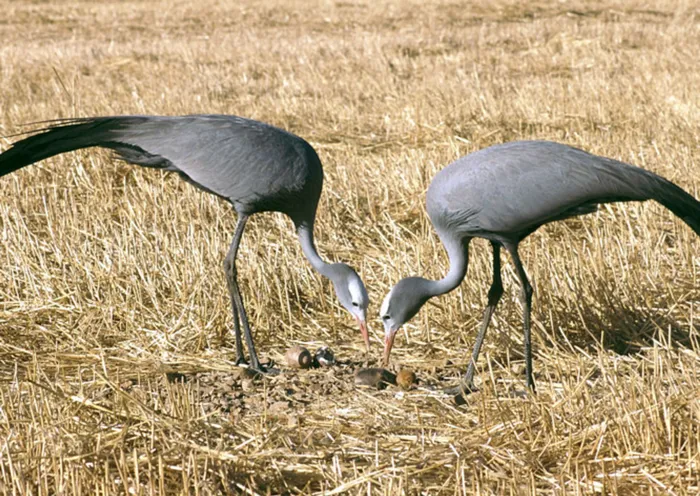The plight of the Blue Crane: Protecting South Africa's national bird

Pair of Blue Cranes with a chick. The population of the Blue Crane, South Africa's national bird, is being monitored by the Endangered Wildlife Trust
Image: ENDANGERED WILDLIFE TRUST
The Blue Crane (Anthropoides paradiseus) is an important element of South Africa’s natural heritage. It is a flagship for conservation in agricultural landscapes, from the rolling grasslands of KwaZulu-Natal to the expansive plains of the Karoo, to the patchwork of crops and renosterveld in the Western Cape.
In marking Heritage Month, the Endangered Wildlife Trust (EWT) said South Africa boasts a variety of cultures, languages and one of the most diverse environments in the world, and an important part of that is the Blue Crane, a species that was uplisted from Near Threatened to Vulnerable in the latest Red Data Book of Birds.
“This change reflects growing concern about the species’ future and underscores the critical role of the Overberg region in renewed energies to protect these elegant birds,” EWT said.
EWT, through its partnership with the International Crane Foundation (ICF), aims to conserve the Blue Crane, with a strong focus on the Western Cape and Karoo.
“By targeting initiatives in these areas, we aim to mirror the success achieved during decades of successful conservation interventions in KwaZulu-Natal and the Northern Cape,” said EWT CEO, Yolan Friedmann.
Blue Cranes are endemic to South Africa, with a small population found in Namibia, making these the world’s most range-restricted cranes. There are less than 30 000 of these birds left in the world.
The expansion of existing activities in the Western Cape and Karoo to safeguard the future of Blue Crane populations includes intensifying the focus on habitat restoration in cooperation with communities and farmers, and addressing threats posed by energy infrastructure.
Until 2010, Blue Crane numbers were increasing and healthy in the Karoo and Western Cape.
However, a recent PhD study supported by the EWT/ICF Partnership, reveals that numbers have subsequently been declining in these areas, especially in the Overberg where counts have dropped by 44% between 2011 and 2025.
This sparked the need for renewed conservation effort underpinned by a multi-stakeholder conservation plan developed with the help of the Conservation Planning Specialist Group, gathering inputs from NGOs, industry, landowners, communities and government, EWT said.
The conservation plan comprises four parts: habitat protection, addressing energy infrastructure impact, ensuring crane-friendly agriculture, and research and monitoring.
EWT said for this to be successful it will require expanding their relationship with energy suppliers in order to mitigate power line threats and improve infrastructure routing, as well as increasing work in the agriculture sector to address threats such as poisoning and breeding disturbance. Blue Cranes are especially dependent on agriculture in the Western Cape, on agricultural habitats in the Karoo and grasslands.
“Our aim is to ensure that the effective implementation of this approach reverses the decline in the Blue Cranes populations in the Karoo and Western Cape, as we have done in the Drakensberg,” said Friedmann.
Cape Times